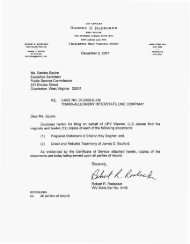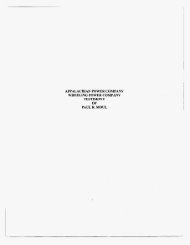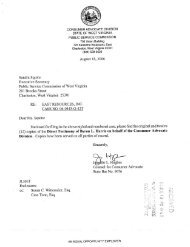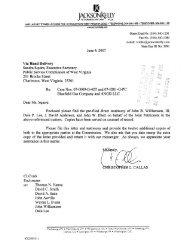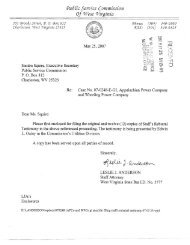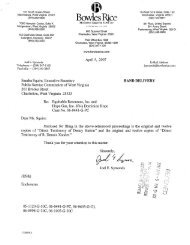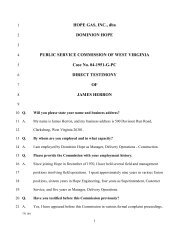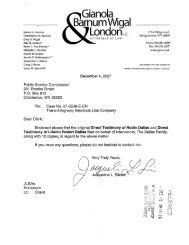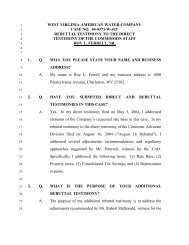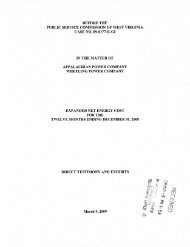Direct Testimony of Thomas M. Hildebrand - Consumer Advocate ...
Direct Testimony of Thomas M. Hildebrand - Consumer Advocate ...
Direct Testimony of Thomas M. Hildebrand - Consumer Advocate ...
Create successful ePaper yourself
Turn your PDF publications into a flip-book with our unique Google optimized e-Paper software.
1 INTRODUCTION<br />
The Commonwealth <strong>of</strong> Virginia currently ranks near the bottoiii <strong>of</strong> all states in expenditures on demandside<br />
nianagement (DSM)'- comprising more efficient uses <strong>of</strong> energ (energy efficiency) and the abiliq.<br />
<strong>of</strong> a consumer to respond to scarcity and high costs (demand response) - according to the American<br />
Council for an Energ)--Efficient Economy (ACEEE) and the Alliance to Saye Energ- (ASE).' This<br />
creates a unique opportunity for the Conimonn.ealth to leverage key lessons learned and best practices<br />
identified in other jurisdictions to develop efficiently and implement a cost-effecti7.e portfolio <strong>of</strong> DSM<br />
program <strong>of</strong>ferings.: Such a portfolio could rely on proven DSM tecluiologies and strategies to achieve<br />
significant energy savings and peak demand reduction over a relatively short timefranie (i.e.. ivitliin moto-three<br />
j-ears). as well as over the longer term. In addition. such a portfolio would generate additional<br />
benefits by protecting ratepayers against future increases in energ! costs. proyiding system reliability<br />
benefits. <strong>of</strong>fering customers the abilic to better manage their energ costs. and maintaining a competitii e<br />
regional economy as businesses increasingly look for locations with robust. diJ.erse energ supplies from<br />
demand-side and supply-side resources.<br />
' For the purposes <strong>of</strong> this report, DSM refers to energy efficiency. demand respnse. and iiino~ativ electric rates designed TCJ<br />
shift energy use from peak demand periods. DSM coT:ers the panoply <strong>of</strong> activiries custoiners can take to nianaee their energ! iise<br />
on their side <strong>of</strong> the meter. The 2Vnfiontrl .Irfion Plan for Energ?, Eflcienq defines energy efficienc!. a5 "Using less energ! to<br />
provide the same or improved le.;el <strong>of</strong> service to the energy consumer in an economically efiicient way The teriii energ!'<br />
efficiency as used here includes using less energy at any time." The US DOE defines demand response as "Chaiiges in eiectnc<br />
usage by end-use customers from their normal consumption patterns in response to changes in the price <strong>of</strong> electriciv over tline.<br />
or to incenti1.e payments designed to induce lower eIectrici6 use at times <strong>of</strong> high \\holesale market prices or nhen s!'stem<br />
relinbilip is jeopardized." '4s specified in the report Een&ts <strong>of</strong> Demnd Respume hi Elecrncir?, .Lfarkers mid Recommei?n'nho?ls<br />
for Achieving Them. the US DOE identifies two primq tspes <strong>of</strong> demand response: (1) Price-based demand response slrcll as<br />
real-time pricing (RTP). critical-peak pricing (CPP) and time-<strong>of</strong>-use (TOU) tariffs. give customers time-vFing rates that reflect<br />
the \due and cost <strong>of</strong> electricit\i in different time periods. h e d with this infonnation customers tend to use less electricit\ at<br />
times \\hen electricitl; prices are high mid (2) 1ncenti.c-e-based demand response program pa! participating custoniers to reduce<br />
their loads at times requested b!' the program sponsor. triggered either by a grid reliabilih. problem or high electricin prices.<br />
Dan York Rr Martin Kushler. American Council for an Enerav-Efficient Econornv. .iCEEE's 3rd .\irtiontr/ Scoreborrrd oil<br />
' Numerous sources exist compiling DSM best practices including the US DOE and US EPA. 3'afioml rlcrion Plan for Etrerg,<br />
Eficiency. (July 2006); US EPA. Clean Energy-Emironmefit Guide to .-1ctio~7. Policies. Be57 Practices. mid .4ciiotz Steps for<br />
Smtes. (April 2006): and California Best Practices Project Advisory Committee. .Yafional Energy&ficzenq~ Besr Pracrices Siz~d,<br />
(Dec. 20043. http: I wwn..eebestpractices.coin<br />
-1-



